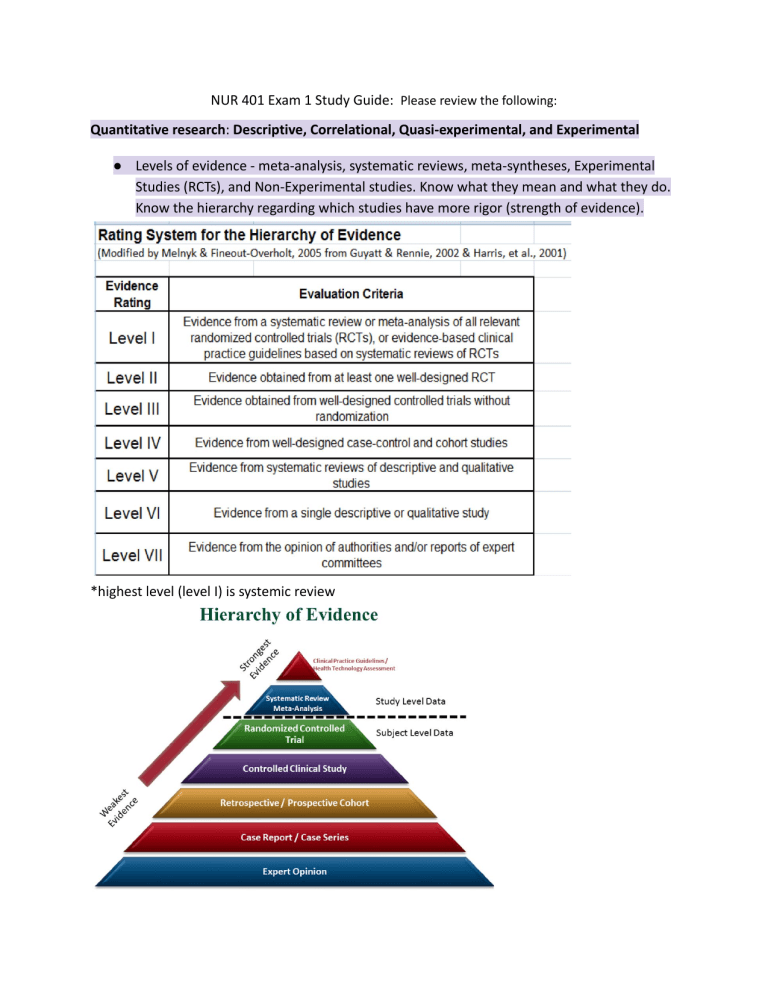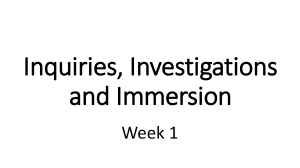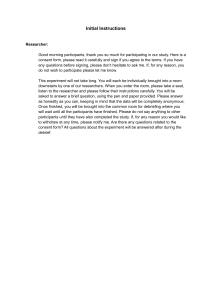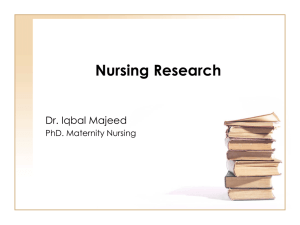
NUR 401 Exam 1 Study Guide: Please review the following: Quantitative research: Descriptive, Correlational, Quasi-experimental, and Experimental ● Levels of evidence - meta-analysis, systematic reviews, meta-syntheses, Experimental Studies (RCTs), and Non-Experimental studies. Know what they mean and what they do. Know the hierarchy regarding which studies have more rigor (strength of evidence). *highest level (level I) is systemic review ● Difference between assumptions, concepts, philosophies, and theories in research. ○ Assumptions→ statements that are taken for granted or are considered true ■ Unrecognized in thinking and behavior ■ “Universally accepted truths” ○ Concepts→ an idea that has been formally developed and organized ■ More loosely structured than theories ■ Can serve as springboards for generating hypotheses ■ “Building blocks” ■ Abstractly describe and name an object, idea, or phenomenon, thus providing it with a separate identity or meaning ○ Philosophies→associated with assumption, knowledge and nature of the study. ■ Set of beliefs and reality ○ Theories→ an abstract generalization that explains how phenomena are interrelated ■ Set of concepts and statements that present a view of the phenomenon ■ Explains something… focuses on the general ● Research methods: Control, Explanation, Evaluation, and Prediction. Know what a research problem and a problem statement are used for. ○ Control→ manipulates the situation to produce the desire outcome ○ Explanation→ clarify relationships among phenomena, identify possible reasons why events occur ○ Prediction→ estimate the probability of a specific outcome in a given situation ○ Research Problem→ an area of concern in which there is a gap in knowledge needed for practice ■ The problem identifies, describes, or predicts the research situation ■ Significance: current, important area of concern for the profession ■ Background: 1 or 2 key studies that have been conducted related to the problem ■ F.I.N.E.R→ Feasible, Interesting, Novel, Ethical, Relevant ○ Problem Statement→ purpose is justification of need ■ Current (timely) ■ Significance for nursing ■ Clear, concise statement ■ Explain the goal, aim, focus, or objective of the study ■ Includes variables, populations, and setting ● Purpose of research (describe, explain, predict, control). ○ Research Purpose→ comes from the problem and identifies the specific goal or aim of the study *purpose is to describe, explain, predict, and control ■ The purpose includes variables, population, and setting for the study ■ Determine differences between groups ■ Examine relationships among… ■ Determine the effect of… ● Problem statements ○ Should build on previous research ○ Should influence nursing practice ○ Promotes theory testing or development ○ Addresses nursing research priorities ○ Feasibility: ■ Research expertise ■ Money/Time commitment ■ Availability of subjects, facilities, and equipment ■ Ethical considerations ● Differences between quantitative and qualitative research and examples of each. ○ Quantitative Research→ formal, OBJECTIVE, rigorous, systemic process for generating NUMERICAL information (tests theory) ■ Describes new situations, events, or concepts ■ Examines relationships among variables ■ Determines the effectiveness of treatments ■ Data analysis occurs sequentially with data collection ■ Concepts Relevant: ● Basic Research→ generates/refines theory… includes lab investigations with animals or humans ● Applied Research→ attempts to solve real problems in clinical practice… findings in the real world on real patients ● Rigor→ logical reasoning is essential… precision, accuracy, detail, and order required ● Control→ rules to follow to decrease the possibility of error due to the design of the study ○ Increases the probability that findings are an accurate representation of reality ● Extraneous Variables→ may interfere with the hypothesized relationships between variables ○ Influence can be decreased through sample selection ○ Researchers need to control these variables as much as possible for more accuracy ● Sampling→ process of selecting subjects who are representative of the population ○ Random sampling… has the most control ○ Convenience sampling ○ Qualitative Research→ systematic, SUBJECTIVE approach used to describe life experiences and give them meaning (theory development) ■ Useful in understanding human experiences such as pain, caring, powerlessness, and comfort ■ Focuses on understanding the whole ■ Consistent with the holistic philosophy of nursing ■ Data incorporates perceptions and beliefs of the researcher/participants ■ Data analysis occurs concurrently with data collection *goal IS NOT hypothesis testing… focus is on studying the “whole” ● What is a hypothesis? What is a null hypothesis? ○ Hypothesis→ a prediction… can be statistically tested & may be accepted or rejected ■ Predict a relation between variables & statistically tested to conclude the study ○ Null Hypothesis→ States there is no difference or relationship between variables ■ “Statistical Hypothesis”... “Non-Directional” ■ Example: there is no difference between attitudes of men and women toward caring for people with AIDS ● Know the parts of Research (design, problem, purpose, significance) ○ Design→ blueprint for conducting the study ■ Maximizes control over factors that could interfere with the study’s desired outcome ● ● ● ● ● ■ Directs the selection of the population, sampling, methods of measure, plans for data collection, and analysis ○ Problem→ ○ Purpose→ ○ Significance→ What are concepts? ○ Differences between informed consent and assent. ○ Informed Consent→ participant or legal guardian voluntarily confirms his or her willingness to participate in a particular research project, after having been informed of all aspects of the research that are relevant to the subject's decision to participate. ■ Consent may be given only by someone who is legally able to provide consent. ○ Assent→ the agreement of someone not able to give legal consent to participate in the activity ■ Not competent to give legally-valid informed consent to the research (children 7-17yo) Independent and Dependent Variables and the differences. ○ Independent Variables→ the stimulus or activity manipulated or varied by the research to cause an effect on dependent variables ■ Treatment or Experimental variable ■ Causes the dependent variable to change ■ Independent DOES NOT CHANGE… researcher controls it ○ Dependent Variables→ the outcome or response the researcher wants to predict or explain ■ Changes in the dependent variable are presumed to be caused by the independent variable Know the difference between a control group and an intervention group. ○ Control Group→ comprised of people who do not receive the medication that the researchers are studying ○ Intervention Group→ “treatment group” ■ receives the treatment whose effect researchers wish to study Steps of a research study… First, Identify the research problem, develop assumptions, explore the background for the research problem, and state the research purpose. ○ RESEARCH PROBLEM & PURPOSE ○ Review of Relevant Literature ○ Study Framework ○ Research Objectives, Questions, or Hypothesis ○ Study Variables ○ Study Design ○ Population and Sample ○ Measurement Methods ○ Data Collection ○ Data Analysis ○ DISCUSSION OF RESEARCH OUTCOMES ● Know the purpose of systematic reviews. ○ A rigorous synthesis of research findings on a particular research question obtained by using systematic sampling and data collection procedures and a formal protocol ■ Review by experts in the field of all the research on a topic ■ “Systematic reviews search, appraise and collate all relevant empirical evidence in order to provide a complete interpretation of research result” ● Difference between a Meta-analysis and Meta-synthesis. ○ Meta-Analysis→ a technique for quantitatively integrating the results of multiple similar studies addressing the same research question ○ Meta-Synthesis→ interpretive translations produced from the integration or comparison of findings from qualitative studies on a specific topic ● Know the difference between RCT, experimental, quasi-experimental, correlational, and descriptive studies. What is the purpose of the evidence hierarchy? ○ Descriptive→ Exploration and description of phenomena in real-life situations ■ New meaning is discovered and the description of concepts is accomplished ■ Helps to identify relationships ■ Answers… What is? What are? How much? How often? ○ Correlation→ looks at relationship between 2 or more variables ■ Determines the strength and type of relationship ■ Explains what is seen ■ NO cause and effect ○ Quasi-Experimental→ examines CAUSE & EFFECT relationships ■ Less control by the researcher than true experimental designs ■ Samples are NOT RANDOMLY selected ● Researcher cannot control all variables in the study ■ Pre-Test Post-Test Design ○ Experimental (RCT)→ Controlled manipulation of at least 1 independent variable ■ Uses experimental and control groups ■ Random assignment of the sample to the experimental and control groups ■ Looks at Cause & Effect relationships ■ HIGHLY CONTROLLED, objective, systemic studies ■ Independent and dependent variables ○ Purpose of Evidence Hierarchy ■ Involve ranking evidence sources according to the strength of evidence they provide… “quality of evidence” ● What are the parts of a research article? Introduction, Abstract, Methods, Results, Conclusion, and Discussion. ○ Abstract→ summary of the study in 100-250 words ■ READ THIS FIRST ● Brief overview of study ○ Introduction→ problem, purpose, literature, framework, and hypothesis ■ Introduce the problem ■ Describe significance ■ Context ■ Purpose of the study ■ Research question ○ Methods→ design, sample, setting, tool ■ design/setting ■ Participants ■ Procedures ■ Measures ■ Analysis plan ○ Results→ data analysis procedures ■ Organized with research questions ● Quantitative: statistical tests (p<0.05) ● Qualitative: themes, meanings ■ Most tables/figures ○ Discussion→ findings, conclusions, implications ■ Text summary of results ■ Integrate.compare results to past studies, or to results expected from theory ○ Conclusion→ research (future), practice, policy Qualitative research: Ethnographic, Grounded Theory (creates theories), Historical, Phenomenological. ● 5 Approaches: ○ Phenomenological→ meaning of one’s lived experiences ■ “What is the lived experience of midlife adult women survivors of breast cancer” ○ Ground Theory→ used most frequently to study areas in which little previous research has been conducted ○ Ethnography→ focuses on “culture” ○ Exploratory-Descriptive-Qualitative→ provide insight/information into clinical/practice problems ■ “Contexts in which individuals experience loss” ○ Historical→ examines events in the past ■ “How nurses were involved in preventing infant mortality between 1884 and 1925” ● Qualitative researchers do not develop hypotheses prior to data collection. ○ ● Qualitative studies may be used to create a theory. ○ ● What is Hermeneutics? ○ Interpretive Phenomenology… based on the philosophy of Heidegger ○ Heideggerian: Hermeneutics as a basic characteristic of human existence ■ Emphasis on interpreting and understanding experience, not just describing it ■ “concerned with the ways in which humans derive meaning from language or other symbolic expression” ■ Relies on in-depth interviews and supplementary data sources: texts, artistic expression *experiences are valuable ● What is bracketing? ○ The process of identifying and holding in abeyance preconceived beliefs and opinions about the phenomenon under study ○ Used in some phenomenological research to help researcher avoid misinterpreting phenomenon as participants are experiencing it *Suspending or laying aside what the research knows about the experience being studied ● Review Dr. Reave’s Qualitative presentation. Purpose, data collection, type of study, etc. “The Lived Experience of Parents of Children with Special Healthcare Needs on Public and Private Insurance: A Phenomenological Study ○ Purpose→ To understand the experiences of parents of Children with Special Healthcare Needs (CSHCN) ■ Looked at lived experiences of parents ○ Data Collection→ ■ Sample… 16 parents (14 females and 2 males) ■ 2 digital recorders ● 60-90 minutes ■ Transcribed by researcher ■ Compared interview transcripts with the audio for credibility ■ REDcap &Max QDA ○ Type of Study→ Qualitative Description Design, study rigor ○ Themes→ ■ Struggle for Self-Preservation ● Avoid own health ■ Abandonment & Isolation ● Not using the insurance ○ Inadequate coverage for their child ○ Ineligible for supplemental programs ● Isolation from friends and family ■ Self-Reliance & Advocacy ● Do own research so others understand ■ Interdependence ■ Lifeline ○ Summary→ findings from this study highlighted major differences of parents navigating CSHCN insurance ■ Type of insurance ■ Sources of support ■ Parents’ satisfaction with the adequacy and costs Evidence-Based Nursing Practice: consists of the best research evidence, clinical expertise, and the needs and values of patients. ● PICOT. What does it mean? What can it be used for? ○ “Defining the question” ○ P: Population or participants of interest in your clinical setting ○ I: Intervention needed for practice ○ C: Comparisons of interventions to determine the best intervention for your practice ○ O: Outcomes needed for practice and ways to measure the outcomes in your practice ○ T: Timing of study needed for intervention to achieve outcome ■ Time is an option as it can limit your search ● Basic rationales for Evidence-Based Practice in Nursing ○ Treatment/Intervention ○ Assessment & Diagnosis ○ Prognosis ○ Harm & Etiology ○ Meaning & Process ○ BSN→ primary role is to identify research problems ■ Assist with data collection ■ Critique research studies ■ Summarize research findings for use in practice ● Know what role qualitative research plays in evidence-based practice (EBP) ○ Develops an empirical knowledge base ○ Identifies best practices… apply evidence in your clinical practice ○ Produces decisions that are clinically appropriate, cost-effective, and result in positive client outcomes ○ Improves outcomes for: ■ Patient and family ■ Nurse ■ Healthcare system ● Know what evidence-based practice is and what it is not. ○ Research and clinical for better practice ○ Synthesis of knowledge ○ Making a change in practice ○ Evaluation of change for patient, provider, and health care system ■ Quality, safety, and cost-effective outcomes NOT a “one size fits all” approach to healthcare… NOT a cost-cutting practice or method for rationing healthcare services ● Focusing on the Patients/clients is essential. ○ Ethical principles and concepts in research: ● Ethical principles and violations in history, such as the Tuskegee syphilis study. ○ Ethical studies protect subjects and are carried out using scientific principles ■ Protect human rights ■ Understanding informed consent ■ Understanding institutional review of research ■ Balancing benefits and risks in a study ○ Unethical studies: ■ Scientific misconduct ■ Fraud, research protocol violations ■ Fabrication, falsification, forging of data ■ Plagiarism ■ Putting subjects at risk without consent ○ Tuskegee Syphilis Study→ ■ The study initially involved 600 Black men – 399 with syphilis, 201 who did not have the disease. Participants’ informed consent was not collected. Researchers told the men they were being treated for “bad blood,” a local term used to describe several ailments, including syphilis, anemia, and fatigue. In exchange for taking part in the study, the men received free medical exams, free meals, and burial insurance. ● Penicillin was used to treat syphilis but participants were NOT offered treatment ● What is the purpose of an institutional review board (IRB)? ○ Protection of human subjects in research ■ Additional protection for pregnant women, human fetuses, neonates, children, and prisoners ■ Documentation of informed consent ○ Functions: ■ Protection of rights and welfare ■ Voluntary informed consent ■ Benefits exceed risks ● Define Beneficence, Ethics, Justice, and Respect for persons. ○ Beneficence→ DO NO HARM… freedom from exploitation ■ Maximize possible benefits and minimize possible harm ○ Ethics→ ○ Justice→fairness in distribution or what is deserved ■ To each person, an equal share ■ To each person according to individual need/effort, societal contribution, and to merit ● Fair treatment, even if the person chooses not to participate ● Confidentiality ○ Respect for persons→ individuals should be treated as autonomous agents ■ Persons with diminished autonomy are entitled to protection ● Self-determination… no coercion ● Full disclosure… no deception ● Voluntary consent ● Know the right to self-determination. ○ Self-determination to participate and withdraw ○ Humans are autonomous agents with the freedom to conduct their lives as they choose ○ This will be violated by… coercion, covert data collection, deception ● 5 Human Rights: Right to self-determination, privacy, anonymity/confidentiality, fair treatment, and protection from discomfort and harm Nursing Specific: ● Why did nursing theories develop in the 1960s? ○ focused on the patient's rights and shifted the focus of care from being task oriented to being patient oriented ● What is the purpose of nursing research? ○ Ensure the best practice… find new solutions and ask why ○ To search again ○ To examine carefully ○ Diligent and systematic inquiry ○ Discovery ○ GOAL→ is to develop an empirical body of knowledge for our discipline *Began in the 19th century with Florence Nightingale… clean air (open windows to get out the germs) ● QSEN→ founded in 2005 by Robert Wood Johnson Foundation ○ An initiative focused on developing the requisite knowledge, skills, and attitude statements for each of the competencies for prelicensure and graduate education https://quizlet.com/brriiiiannna/folders/evidence-based-exam-1?i=w43qk&x=1xqY ^^quizlet is for chapter 1, 2, 3, 4, 5, 7 (Exam 1 content) PowerPoint Questions: SOMEONE CHECK THESE ANSWERS PLEASE Chapter 1 1. Identifying and Understanding the nature of nursing phenomena and the relationships among the phenomena are examples of ______ AND ______ a. Description b. Explanation c. Prediction d. Control 2. The beginning nurse researcher would like to investigate credible resources for implementing protocols in clinical practice. Which of the following would be considered empirical sources of nursing knowledge? a. Reasoning, authority, and tradition b. Quantitative, qualitative, and outcomes research c. Care maps and protocols d. Role modeling and trial and error 3. The nurse researcher is investigating outcomes research on nursing interventions. Which of the following examples would constitute outcomes research? a. A comparison of 2 patient groups b. Patient responses to nursing intervention c. Patient tested before and after intervention d. A patient’s perception of the intervention 4. Research findings increasingly must meet the test of being clinically significant and medical practitioners have taken center stage in efforts to define clinical significance a. True b. False 5. What is the best method of acquiring reliable knowledge on which to base a clinical practice? a. Traditions and authority b. Clinical experience and trial and error c. Assembled information d. Disciplined research 6. Quantitative research attempts to identify a phenomenon a. True b. False Chapter 2 1. A staff nurse is interested in the infection rates for patients who have indwelling Foley catheters. What is the next step in the research process? a. Defining the purpose b. Conducting the literature review c. Selecting study variables d. Performing a pilot study 2. The nurse researcher is involved in selecting a sample for research study on staffing ratios. Which statement best describes the difference between a population and a sample? a. A population is usually larger than a sample b. A sample is usually larger than a population c. Populations and samples are synonymous d. There is no relationship between sample size and population size Chapter 3 1. Which of the following is true about qualitative research a. Categories are established for analysis purposes b. Data are usually collected in a laboratory setting c. Focus is on studying the “whole” d. Intuition and abstraction are suppressed 2. Data for qualitative studies are: a. Based on words rather than numbers b. Easy and straightforward to interpret c. Gathered quickly from large numbers of people d. Precisely analyzed on a computer 3. Which of the following is not a common data collection method in qualitative research a. Examining written text b. Interviewing participants c. Observing participants d. Obtaining written surveys Chapter 4 1. A researcher who does not disclose that a portion of the data from the original study sample was not used in the final data analysis could be accused of a. Infidelity b. Lack of scientific objectivity c. Plagiarism d. Scientific misconduct 2. The nurse researcher is involved in selecting a sample for an outcomes research study on staffing ratios. Which of the following is a generally accepted guideline to follow? a. Specific patients are represented b. Heterogenous samples are preferred c. Random sampling is very desirable d. Small samples are needed 3. A nurse researcher is conducting an outcomes research study and would like to focus on patient care. Which outcome would be most valuable to examine? a. Assessment b. Care planning c. Interventions d. Evaluation Chapter 5 1. The initial and one of the most significant steps in conducting the research process is: a. Defining the research variables b. Determining the feasibility of the study c. Identifying the research problem d. Stating the research purpose 2. How is the feasibility of the problem and purpose identified? a. Availability of subjects b. Previous studies c. Researcher’s credibility d. Significance of the research problem 3. The research purpose should identify the study variable(s) and what other key aspects of the study a. Design b. Measurement tools c. Population d. Statistics Chapter 7 1. Conceptual models and theories are similar in that a schematic model can represent both a. True b. False 2. Which of the following is true about theoretical frameworks used in research a. Theories are constructed by people and are tentative in nature b. Theories offer precise guidance in all situations c. Theories represent the ultimate truth d. Theories are congruent with reality 3. What does a study framework reflect a. Blueprint for the study b. Data analysis strategy c. Researcher’s “theory” or idea about the study d. Specific plan for data collection 4. Which of the following is an example of a theory from a physiological background that nurses use as a framework for nursing studies a. Gate control theory of pain b. Health promotion model c. Social cognitive theory d. Theory of coping



